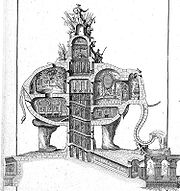
Charles Ribart
Encyclopedia

France
The French Republic , The French Republic , The French Republic , (commonly known as France , is a unitary semi-presidential republic in Western Europe with several overseas territories and islands located on other continents and in the Indian, Pacific, and Atlantic oceans. Metropolitan France...
architect
Architect
An architect is a person trained in the planning, design and oversight of the construction of buildings. To practice architecture means to offer or render services in connection with the design and construction of a building, or group of buildings and the space within the site surrounding the...
.
Architectural career
In 1758, he planned an addition to the Champs-ÉlyséesChamps-Élysées
The Avenue des Champs-Élysées is a prestigious avenue in Paris, France. With its cinemas, cafés, luxury specialty shops and clipped horse-chestnut trees, the Avenue des Champs-Élysées is one of the most famous streets and one of the most expensive strip of real estate in the world. The name is...
in Paris
Paris
Paris is the capital and largest city in France, situated on the river Seine, in northern France, at the heart of the Île-de-France region...
, to be constructed where the Arc de Triomphe
Arc de Triomphe
-The design:The astylar design is by Jean Chalgrin , in the Neoclassical version of ancient Roman architecture . Major academic sculptors of France are represented in the sculpture of the Arc de Triomphe: Jean-Pierre Cortot; François Rude; Antoine Étex; James Pradier and Philippe Joseph Henri Lemaire...
now stands. It consisted of three levels, to be built in the shape of an elephant
Elephant
Elephants are large land mammals in two extant genera of the family Elephantidae: Elephas and Loxodonta, with the third genus Mammuthus extinct...
, with entry via a spiral staircase in the underbelly. The building was to have a form of air conditioning
Air conditioning
An air conditioner is a home appliance, system, or mechanism designed to dehumidify and extract heat from an area. The cooling is done using a simple refrigeration cycle...
, and furniture that folded into the walls. A drainage system was to be incorporated into the elephant's trunk. The French Government, however, was not amused and turned him down. Napoleon would later conceive a similar construction, the Elephant of the Bastille
Elephant of the Bastille
The Elephant of the Bastille was a monument in Paris between 1813 and 1846. Originally conceived in 1808 by Napoleon, the statue was intended to be created out of bronze and placed in Place de la Bastille, but only a plaster full-scale model was built...
.
Little of his work now survives.
See also
- Lucy the ElephantLucy the ElephantElephant hotel redirects here. For the National Historic Landmark located in Somers, New York, see Elephant Hotel.Lucy the Elephant is a six-story elephant-shaped example of novelty architecture, constructed of wood and tin sheeting in 1882 by James V...
- Elephant of the BastilleElephant of the BastilleThe Elephant of the Bastille was a monument in Paris between 1813 and 1846. Originally conceived in 1808 by Napoleon, the statue was intended to be created out of bronze and placed in Place de la Bastille, but only a plaster full-scale model was built...
, a Napoleon-era proposal to build an elephant-shaped fountain in Place de la BastillePlace de la BastilleThe Place de la Bastille is a square in Paris, where the Bastille prison stood until the 'Storming of the Bastille' and its subsequent physical destruction between 14 July 1789 and 14 July 1790 during the French Revolution; no vestige of it remains....
.

